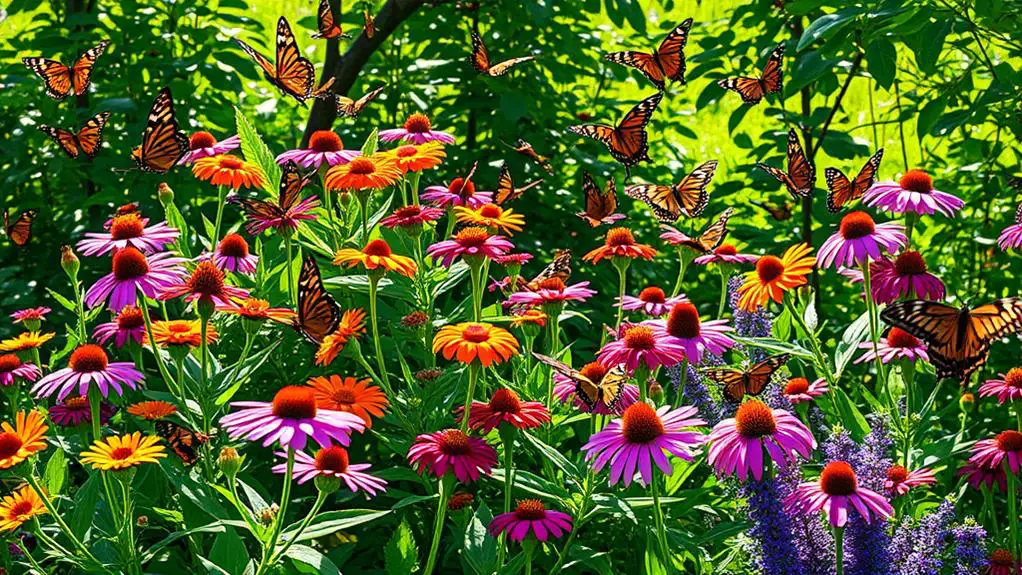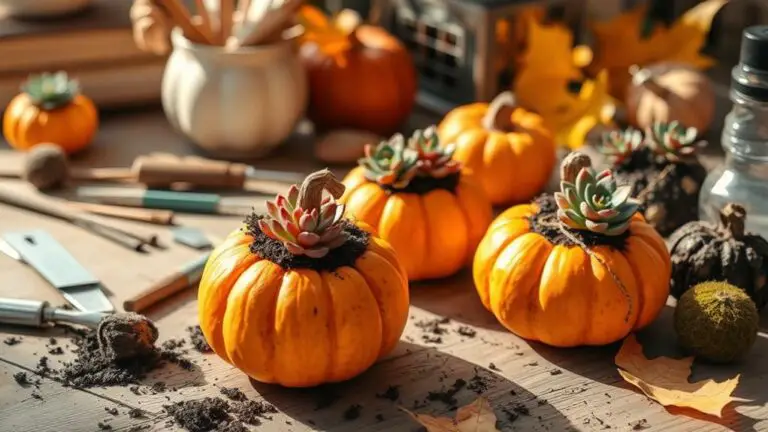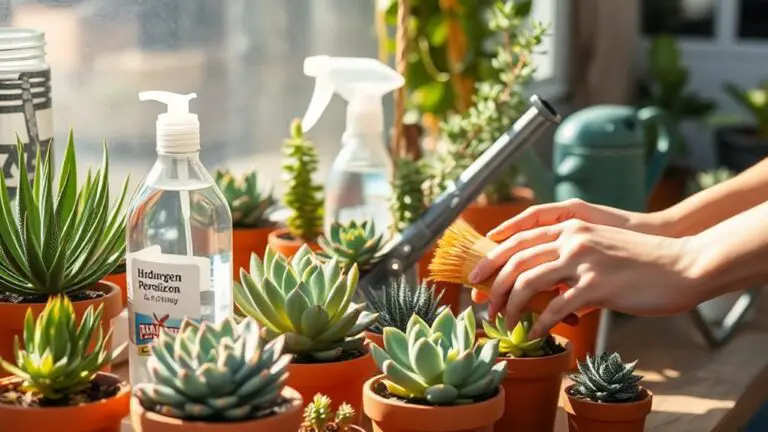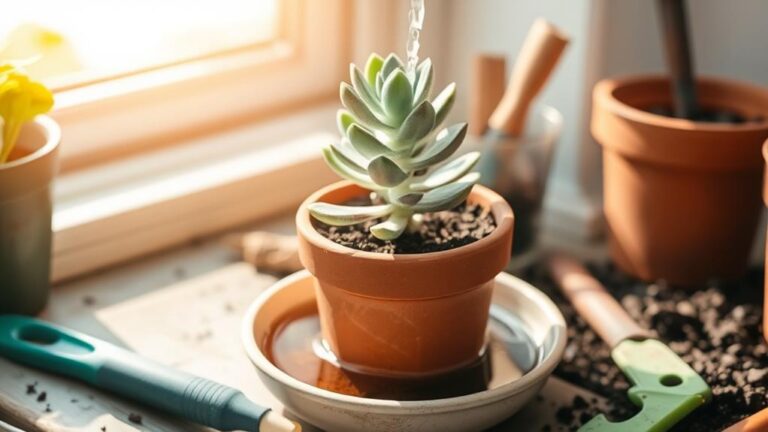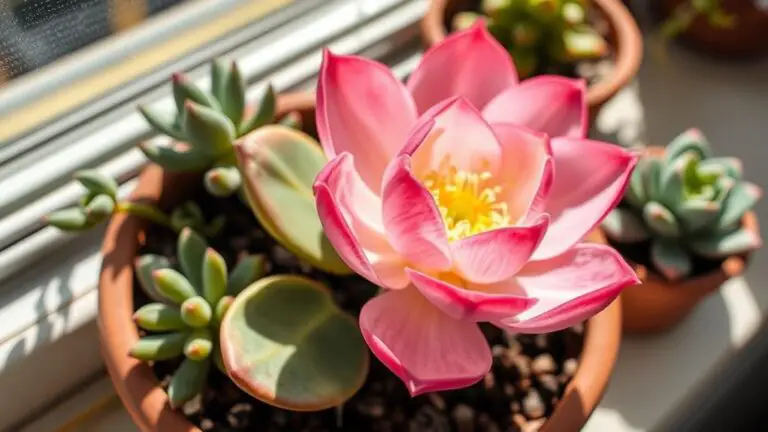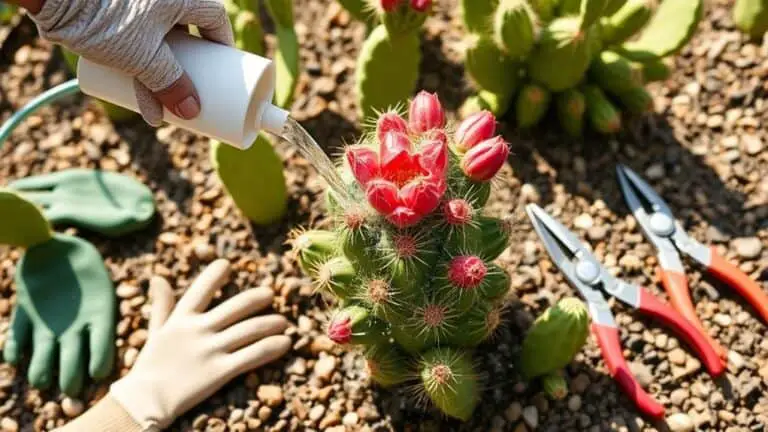7 Plants That Attract Butterflies and Tips for a Vibrant Garden
Creating a vibrant butterfly garden isn't just about adding beauty to your outdoor space; it's also about supporting essential pollinators and enhancing local biodiversity. By choosing the right plants, like marigolds and echinacea, you can attract a host of butterfly species to your garden. But it's not just about the flowers you pick—how you plant them, the amount of sunlight they get, and even simple practices like deadheading can make a big difference. Curious about which other plants to include and how to maintain them for a flourishing garden? Keep reading to uncover the full list and expert tips.
Importance of Butterfly Gardens
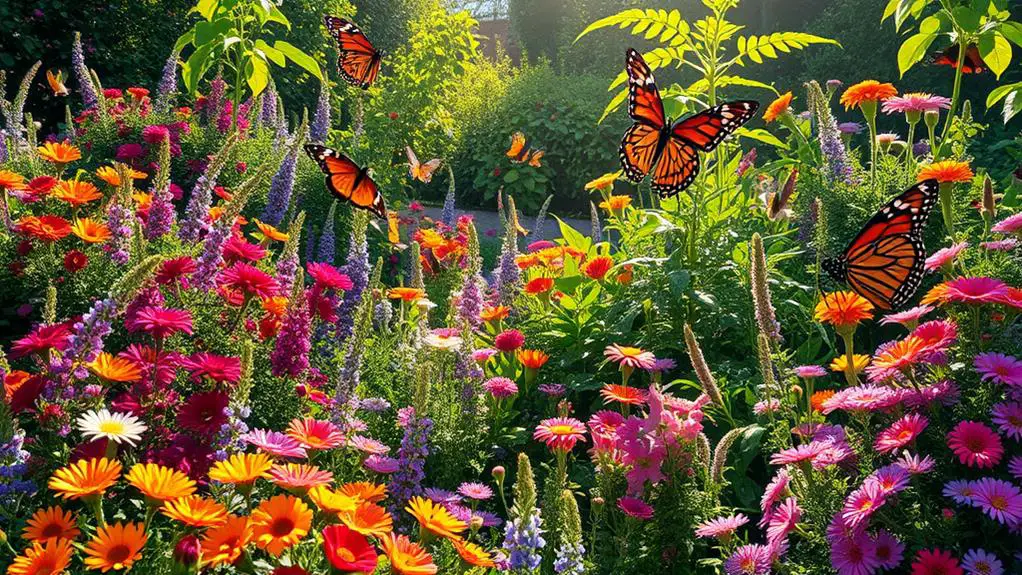
Butterfly gardens aren't just beautiful; they're vital for maintaining healthy ecosystems. By creating these gardens, you're supporting pollinators that play an important role in the reproduction of flowering plants. This, in turn, helps sustain our food supply and boosts ecosystem health. The nectar-rich flowers you plant will attract butterflies, offering them much-needed food sources.
When you establish a butterfly garden, you're not just planting flowers. You're fostering biodiversity by providing habitats for various species. This helps sustain local wildlife populations and supports overall conservation efforts.
In today's world, butterflies are facing habitat loss and declining populations due to pesticide use. Your garden can be a sanctuary for these delicate creatures.
Butterflies aren't just pretty to look at; their presence in your garden is a sign of a healthy ecosystem. They rely on a variety of plant species for food and habitat, so attracting butterflies means your garden is thriving.
By engaging in butterfly gardening practices, you're contributing to global conservation efforts. Many butterfly species are threatened or endangered, and your garden helps preserve their natural habitats.
Marigolds: Bright and Bold
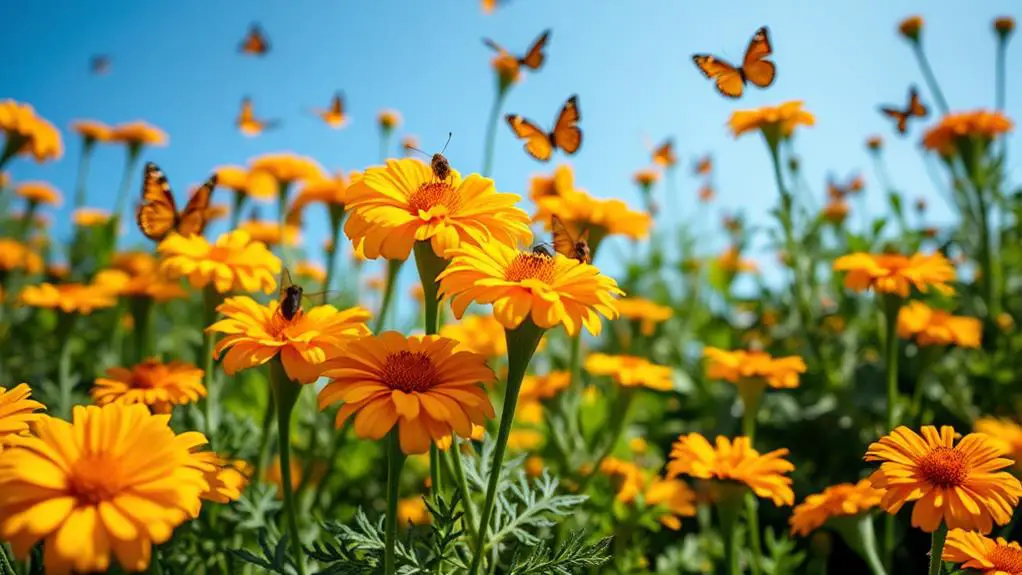
After understanding the importance of butterfly gardens, let's focus on one of the best plants to include: marigolds.
Marigolds are exceptional at attracting butterflies with their bright orange and yellow blooms. These vibrant colors make them stand out, drawing butterflies like magnets.
You'll find marigolds thriving in USDA Zones 2 to 11. They love full sun and moist, well-drained soil. Planting them in masses not only enhances their visibility but also increases their attractiveness to butterflies. This makes marigolds an excellent addition to any butterfly garden. Their blooms provide a steady supply of nectar, keeping butterflies coming back for more.
One of the best things about marigolds is they're low-maintenance. They can adapt to various soil types, making them a versatile choice for both novice and experienced gardeners.
To keep your marigolds blooming all season, regularly deadhead the spent flowers. This simple task encourages prolonged blooming, ensuring a continuous nectar supply for visiting butterflies.
Echinacea: Nectar-Rich Blooms
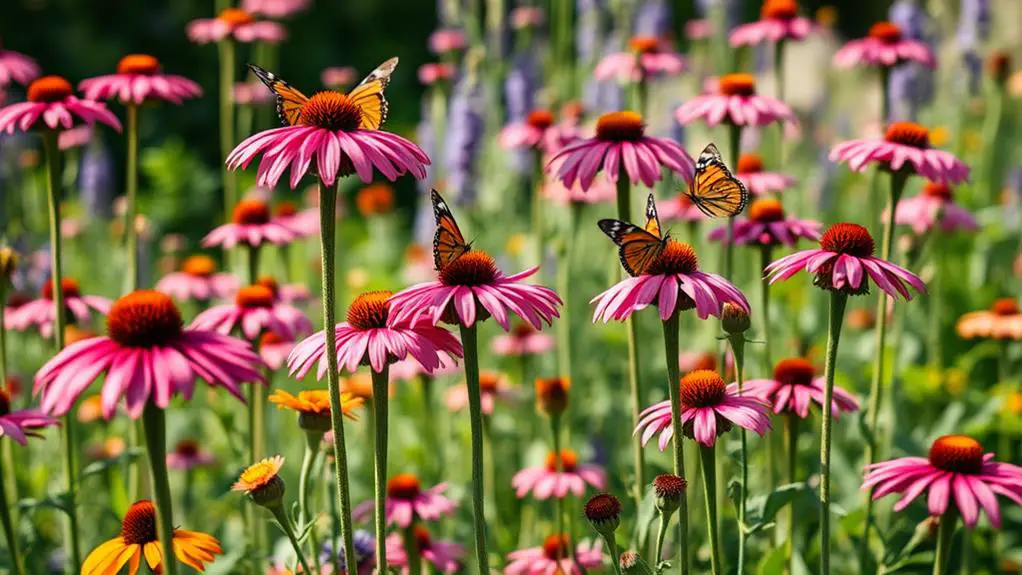
Echinacea, with its vibrant purple petals, is perfect for attracting a variety of butterflies to your garden.
This low-maintenance plant blooms from summer to early fall, giving pollinators a continuous nectar supply.
Plus, Echinacea thrives in full sun and well-drained soil, making it an easy addition to any butterfly garden.
Attracts Various Butterflies
You'll find that coneflowers, known botanically as Echinacea, are a magnet for butterflies, thanks to their nectar-rich blooms. These plants are a go-to choice when planning a garden for attracting butterflies. Their vibrant colors—pink, purple, white, and orange—are like beacons for various butterfly species. Monarchs, swallowtails, and painted ladies are just a few of the butterflies you'll see fluttering around these beautiful flowers.
Echinacea's blooms offer a late-season nectar source, which is essential for migrating butterflies. This means your garden will continue to provide food as other flowers start to fade.
Coneflowers thrive in USDA zones 3 to 9. They prefer well-drained soil and full sun, though they can handle partial shade. These conditions make them versatile and easy to care for, fitting well into many garden settings.
Besides attracting butterflies, Echinacea promotes biodiversity. The seeds provide food for birds during the winter, ensuring your garden is lively year-round.
Long Blooming Season
Why are Echinacea plants a favorite among butterfly enthusiasts? Echinacea, also known as coneflower, features vibrant blooms in shades of purple and pink that attract butterflies and other pollinators. These flowers aren't only beautiful but also serve as a reliable nectar source, making them a key component in any butterfly garden.
Their long blooming season extends from summer into early fall, providing a continuous supply of nectar for butterflies.
One of the reasons Echinacea is so effective at attracting butterflies is its adaptability. Thriving in USDA Zones 3 to 9, this perennial plant prefers full sun to partial shade and can tolerate various garden conditions.
Once established, Echinacea becomes drought-resistant, requiring little water and well-drained soil, which makes it perfect for sustainable gardening.
To guarantee your Echinacea maintains its long blooming season, regular deadheading is essential. This simple task involves removing spent flowers, which encourages the plant to produce more vibrant blooms.
By doing this, you'll keep your garden bustling with butterflies and other pollinators.
Adding Echinacea to your garden is a surefire way to enjoy a beautiful, butterfly-filled space. With minimal effort, you can create a vibrant, nectar-rich haven for these enchanting creatures.
Low Maintenance Plant
The allure of a low-maintenance garden lies in its simplicity and efficiency. If you're looking for a plant that requires minimal care but still creates a beautiful butterfly garden, Echinacea, also known as coneflower, is a perfect choice. This perennial plant thrives in USDA zones 3 to 9 and produces vibrant blooms in purple, pink, or white from summer to early fall. These striking flowers attract butterflies with their rich nectar.
Echinacea is a low maintenance plant that excels in well-drained soil and is drought-resistant, so you won't need to worry about constant watering. Its resilience also means it's resistant to pests and diseases, making gardening easier for you.
Beyond attracting butterflies, Echinacea offers seeds that serve as food for birds during winter, adding extra value to your garden. This plant's medicinal properties are an added bonus, especially if you're interested in herbal remedies.
Echinacea's ease of growth and minimal care requirements make it an excellent choice for any gardener aiming for sustainability. So, if you want your garden to be a haven for butterflies with little effort, consider planting Echinacea and enjoy the vibrant, nectar-rich blooms it brings.
Black-Eyed Susans: Pollinator Favorite
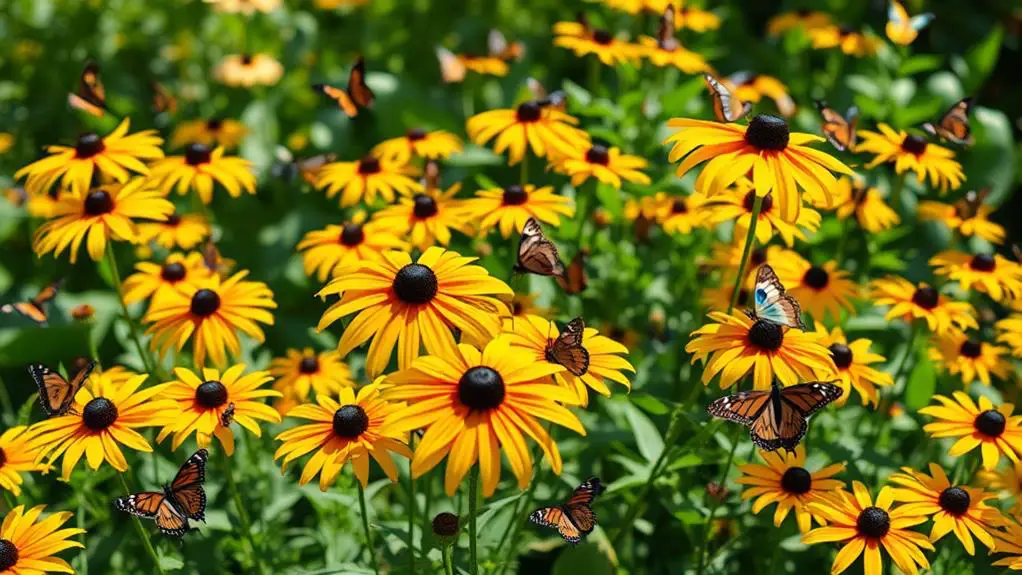
Black-Eyed Susans are a fantastic addition to your garden if you want to attract a variety of butterflies.
Their bright, eye-catching blooms aren't only beautiful but also low maintenance, making them easy to care for.
Plus, these plants support local ecosystems and provide a consistent nectar source from summer to fall.
Attracts Diverse Butterflies
Bright yellow petals and dark centers make Black-Eyed Susans a magnet for a variety of butterfly species, including the great spangled fritillary and pearl crescent.
These vibrant flowering plants are a fantastic addition to your garden, especially if you're aiming to attract butterflies and enhance biodiversity. They offer a consistent nectar source from summer to fall, ensuring your garden remains a hotspot for pollinators throughout the butterfly active season.
Black-Eyed Susans thrive in USDA Zones 3-9 and prefer full sun with well-drained, fertile soil. They can grow up to 4 feet tall, making them adaptable to various garden settings.
Their shallow nectar cups make it easy for butterflies to access their food, ensuring these pollinators return again and again.
Low Maintenance Plant
When looking for a low-maintenance plant that still packs a punch in attracting pollinators, consider planting Black-Eyed Susans in your garden. These vibrant yellow flowers, with their striking dark centers, thrive in USDA Zones 3-9. They require full sun and well-drained soil, making them a versatile addition to your butterfly-friendly space.
Black-Eyed Susans bloom from summer to fall, providing a long-lasting display of brightly colored flowers. Butterflies rely on these blooms for nectar, and you'll notice a variety of butterfly species visiting your garden. Monarch butterflies, in particular, are drawn to these flowers, but they aren't the only ones. Other pollinators, like bees, also find them irresistible.
As a low-maintenance plant, Black-Eyed Susans are drought-tolerant once established. That means less frequent watering is needed, making them perfect if you don't want to spend too much time on garden upkeep. They can grow up to 3 feet tall and adapt well to different soil types, including clay and sandy soils.
In addition to attracting butterflies, the seeds of Black-Eyed Susans provide a valuable food source for birds during the winter, enhancing your garden's biodiversity year-round.
Bright, Eye-Catching Blooms**
Imagine your garden filled with a sea of vibrant yellow blooms, each with a striking dark center that captures the eye. Black-Eyed Susans are a beautiful choice for creating such a scene. These flowers not only add a burst of color but also attract butterflies, making your garden a lively haven.
When you're planting the right flowers, Black-Eyed Susans should be at the top of your list. Their bright yellow petals and dark centers are like beacons to butterflies, drawing them in with the promise of nectar.
These perennials thrive in USDA zones 3 to 9 and can grow up to 3 feet tall, ensuring they stand out in your garden.
One of the best things about Black-Eyed Susans is their adaptability. They flourish in various soil types, including well-drained, loamy, and sandy soils, and they need full sun to bloom their best.
The tubular flowers act as shallow nectar cups, making them perfect for butterflies like the great spangled fritillary and pearl crescent.
Lantana: Colorful Clusters

Lantana draws in butterflies with its vibrant clusters of small flowers, showcasing a spectrum of colors like red, pink, lavender, and yellow. You'll find that this beautiful plant isn't just a feast for the eyes; it's also a reliable source of nectar for butterflies throughout its long blooming period from spring to fall. Lantana loves full sun exposure, which helps it thrive and produce more flowers, making it a favorite in butterfly gardens.
Lantana is hardy in USDA zones 4 to 11 and is wonderfully drought-tolerant once it's established. This means you won't have to worry too much about watering it frequently, which is great if you live in a warmer, dry climate. It also prefers well-drained soil, so make sure you plant it in a spot where water doesn't linger.
| Feature | Details |
|---|---|
| Blooming Period | Spring to Fall |
| Sun Exposure | Full Sun |
| Soil Type | Well-Drained |
| Drought Tolerance | High (once established) |
Butterfly Weed: Monarch Magnet
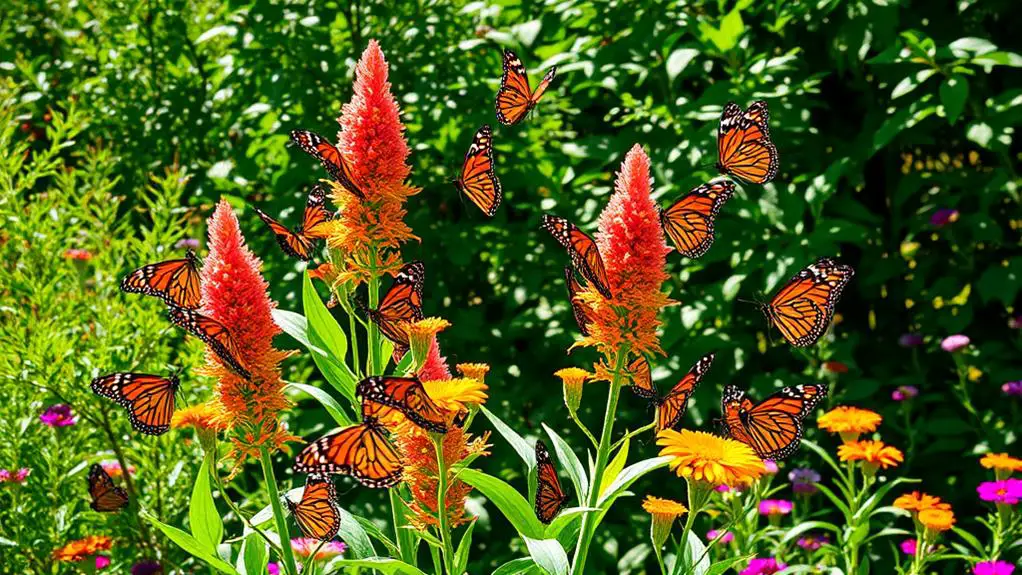
Butterfly weed, scientifically known as Asclepias tuberosa, is a must-have for any butterfly garden due to its striking orange or yellow-orange blooms. This vibrant perennial not only adds a splash of color but also plays an essential role in supporting the monarch butterfly population. Monarch larvae rely on butterfly weed as their vital food source, making it a key plant for your garden if you want to attract these beautiful creatures.
To successfully grow butterfly weed, follow these tips:
- Plant in full sun: Butterfly weed thrives with at least six hours of sunlight each day.
- Choose well-drained soil: Make sure the soil doesn't retain excess water to prevent root rot.
- Water sparingly: Once established, butterfly weed is drought-tolerant and needs minimal watering.
- Support conservation efforts: By planting butterfly weed, you're helping to combat the decline of monarch butterflies.
Butterfly weed blooms from midsummer to early fall, attracting not just monarchs but also a variety of other pollinators, enhancing your garden's biodiversity.
Incorporating this plant into your garden is a step towards promoting conservation efforts and creating a vibrant, thriving outdoor space.
Salvia: Extended Blooming

Following the vibrant allure of butterfly weed, another excellent choice for attracting butterflies to your garden is Salvia. Known for its extended blooming period, Salvia flowers from spring through fall, offering a consistent nectar source for butterflies. Its small, brightly colored spikes are irresistible not only to butterflies but also to hummingbirds, adding even more life to your vibrant garden.
Salvia thrives in USDA Zones 5 to 10 and adapts well to both full sun and partial shade. This makes it a versatile plant for various garden conditions. Once established, Salvia is drought-tolerant, so you won't need to worry about constant watering. Its low-maintenance nature makes it an excellent choice if you're looking for a sustainable, easy-to-care-for plant.
The diverse varieties of Salvia, including blue, lavender, and purple flowers, greatly enhance your garden's aesthetics. These colors attract a wide range of pollinators, supporting butterfly populations throughout the growing season.
Frequently Asked Questions
What Plant Attracts Butterflies the Most?
If you're looking to attract the most butterflies, consider planting the Butterfly Bush. Its highly fragrant and nectar-rich flowers draw a variety of butterflies from summer to fall, making it a top choice for your garden.
What Plant Hosts the Most Butterflies?
You should consider planting milkweed if you're looking to host the most butterflies. It's essential for monarchs, providing food for caterpillars and nectar for adults, ensuring a thriving butterfly population in your garden.
What Perennial Is Known for Attracting Butterflies?
You should consider planting coneflowers. Their vibrant purple petals and rich nectar attract numerous butterfly species. Thriving in USDA zones 3 to 9, these perennials will enhance your garden's beauty while providing essential resources for butterflies.
How Do You Make a Beautiful Butterfly Garden?
You should plant nectar-rich flowers, including natives, for continuous food. Create sunny and sheltered spots for comfort, add a shallow water source, and regularly deadhead and monitor for pests. This guarantees a stunning, butterfly-friendly garden.
Conclusion
Creating your own butterfly garden is easier than you think! By planting marigolds, echinacea, black-eyed Susans, lantana, butterfly weed, and salvia, you're setting the stage for a vibrant, butterfly-friendly space. Remember to plant in masses, keep the soil well-drained, and deadhead regularly. With these tips, your garden will be a colorful haven for butterflies, helping pollinators thrive. You've got the knowledge—now get planting and enjoy your beautiful, buzzing garden!

